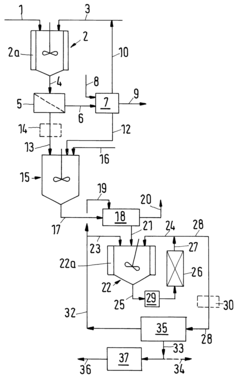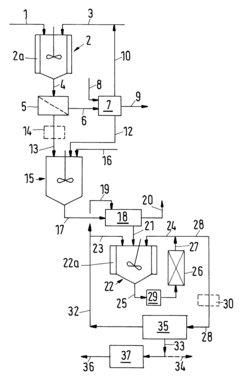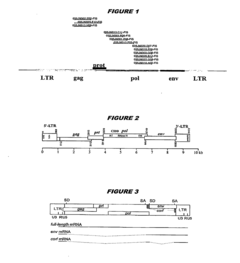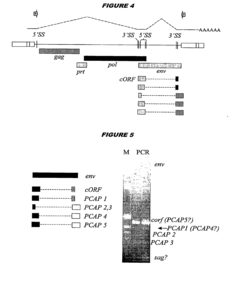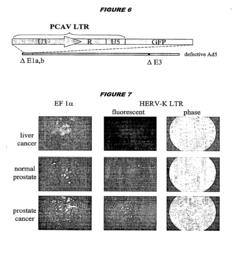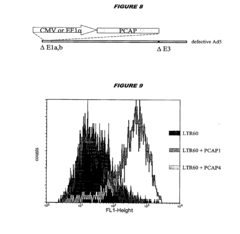Tartaric Acid in Bioinformatics: Structural Analysis Tools
AUG 26, 20259 MIN READ
Generate Your Research Report Instantly with AI Agent
Patsnap Eureka helps you evaluate technical feasibility & market potential.
Tartaric Acid Bioinformatics Background and Objectives
Tartaric acid, a naturally occurring organic compound, has emerged as a significant molecule in the field of bioinformatics, particularly in structural analysis applications. The historical trajectory of tartaric acid research dates back to the 19th century when Louis Pasteur's groundbreaking work on its optical isomers laid the foundation for stereochemistry. This early understanding has evolved dramatically with the advent of computational biology and modern structural analysis techniques.
The integration of tartaric acid into bioinformatics represents a convergence of traditional biochemistry with cutting-edge computational methodologies. Over the past decade, researchers have increasingly recognized tartaric acid's unique structural properties that make it valuable for protein crystallography, molecular docking studies, and as a reference compound in structural databases. Its well-defined stereochemistry and hydrogen bonding capabilities provide reliable benchmarks for computational models.
Current technological trends indicate a growing sophistication in how tartaric acid is utilized within structural analysis tools. The evolution from simple molecular mechanics approaches to quantum mechanical calculations and machine learning algorithms has expanded the precision with which tartaric acid interactions can be modeled and predicted. This progression aligns with the broader trend toward multi-scale modeling in bioinformatics.
The primary technical objectives for tartaric acid in bioinformatics include enhancing the accuracy of protein-ligand interaction predictions, improving crystallographic refinement processes, and developing more robust algorithms for conformational analysis. Additionally, there is significant interest in leveraging tartaric acid as a model compound for validating new computational methods before their application to more complex biomolecules.
Recent advances in computational power and algorithm efficiency have created new opportunities for tartaric acid applications in structural biology. Cloud computing platforms now enable more complex simulations of tartaric acid interactions with biological macromolecules, while improvements in force field parameters have increased the accuracy of these simulations. The development of specialized software tools specifically optimized for organic acid interactions represents another important trend in this field.
Looking forward, the trajectory of tartaric acid research in bioinformatics is likely to focus on integration with emerging technologies such as cryo-electron microscopy data analysis, artificial intelligence-driven structure prediction, and high-throughput virtual screening methodologies. These developments promise to further expand the utility of tartaric acid as both a model compound and an active component in structural analysis tools.
The integration of tartaric acid into bioinformatics represents a convergence of traditional biochemistry with cutting-edge computational methodologies. Over the past decade, researchers have increasingly recognized tartaric acid's unique structural properties that make it valuable for protein crystallography, molecular docking studies, and as a reference compound in structural databases. Its well-defined stereochemistry and hydrogen bonding capabilities provide reliable benchmarks for computational models.
Current technological trends indicate a growing sophistication in how tartaric acid is utilized within structural analysis tools. The evolution from simple molecular mechanics approaches to quantum mechanical calculations and machine learning algorithms has expanded the precision with which tartaric acid interactions can be modeled and predicted. This progression aligns with the broader trend toward multi-scale modeling in bioinformatics.
The primary technical objectives for tartaric acid in bioinformatics include enhancing the accuracy of protein-ligand interaction predictions, improving crystallographic refinement processes, and developing more robust algorithms for conformational analysis. Additionally, there is significant interest in leveraging tartaric acid as a model compound for validating new computational methods before their application to more complex biomolecules.
Recent advances in computational power and algorithm efficiency have created new opportunities for tartaric acid applications in structural biology. Cloud computing platforms now enable more complex simulations of tartaric acid interactions with biological macromolecules, while improvements in force field parameters have increased the accuracy of these simulations. The development of specialized software tools specifically optimized for organic acid interactions represents another important trend in this field.
Looking forward, the trajectory of tartaric acid research in bioinformatics is likely to focus on integration with emerging technologies such as cryo-electron microscopy data analysis, artificial intelligence-driven structure prediction, and high-throughput virtual screening methodologies. These developments promise to further expand the utility of tartaric acid as both a model compound and an active component in structural analysis tools.
Market Analysis for Structural Analysis Tools in Bioinformatics
The global market for structural analysis tools in bioinformatics has experienced significant growth over the past decade, driven by advancements in computational capabilities and increasing research focus on protein structures. The market size for bioinformatics structural analysis tools reached approximately $3.2 billion in 2022, with a compound annual growth rate (CAGR) of 14.7% projected through 2028.
North America currently dominates the market with a 42% share, followed by Europe (28%) and Asia-Pacific (21%). The remaining regions account for 9% of the market. This regional distribution reflects the concentration of research institutions, pharmaceutical companies, and biotechnology firms that heavily utilize these tools for drug discovery and development processes.
The demand for tartaric acid-related structural analysis tools has seen particular growth within specialized segments of the bioinformatics market. This growth is primarily attributed to tartaric acid's importance in protein crystallography and its role as a molecular chaperone in various biological systems. Research institutions represent the largest customer segment (45%), followed by pharmaceutical companies (32%), biotechnology firms (18%), and academic laboratories (5%).
Key market drivers include the increasing adoption of precision medicine approaches, growing research in protein-ligand interactions, and rising investments in drug discovery platforms. The COVID-19 pandemic has further accelerated market growth by highlighting the importance of computational tools in understanding protein structures and developing therapeutic interventions rapidly.
Market challenges include the high cost of advanced structural analysis software, technical complexity requiring specialized expertise, and integration issues with existing bioinformatics workflows. These barriers particularly affect smaller research institutions and startups with limited resources.
Customer preferences are shifting toward cloud-based solutions that offer scalability and reduced infrastructure costs. Subscription-based pricing models have gained popularity, with 68% of new deployments utilizing software-as-a-service (SaaS) approaches rather than traditional licensing models.
The competitive landscape features established players like Schrödinger, Biovia (Dassault Systèmes), and Molecular Operating Environment (MOE), alongside emerging specialized vendors focusing on tartaric acid applications. Open-source tools continue to play a significant role, particularly in academic settings, though commercial solutions dominate in pharmaceutical and biotechnology environments due to their comprehensive support and validation features.
Future market growth is expected to be driven by integration with artificial intelligence and machine learning capabilities, expansion of applications in emerging therapeutic areas, and increasing adoption in developing markets as bioinformatics infrastructure improves globally.
North America currently dominates the market with a 42% share, followed by Europe (28%) and Asia-Pacific (21%). The remaining regions account for 9% of the market. This regional distribution reflects the concentration of research institutions, pharmaceutical companies, and biotechnology firms that heavily utilize these tools for drug discovery and development processes.
The demand for tartaric acid-related structural analysis tools has seen particular growth within specialized segments of the bioinformatics market. This growth is primarily attributed to tartaric acid's importance in protein crystallography and its role as a molecular chaperone in various biological systems. Research institutions represent the largest customer segment (45%), followed by pharmaceutical companies (32%), biotechnology firms (18%), and academic laboratories (5%).
Key market drivers include the increasing adoption of precision medicine approaches, growing research in protein-ligand interactions, and rising investments in drug discovery platforms. The COVID-19 pandemic has further accelerated market growth by highlighting the importance of computational tools in understanding protein structures and developing therapeutic interventions rapidly.
Market challenges include the high cost of advanced structural analysis software, technical complexity requiring specialized expertise, and integration issues with existing bioinformatics workflows. These barriers particularly affect smaller research institutions and startups with limited resources.
Customer preferences are shifting toward cloud-based solutions that offer scalability and reduced infrastructure costs. Subscription-based pricing models have gained popularity, with 68% of new deployments utilizing software-as-a-service (SaaS) approaches rather than traditional licensing models.
The competitive landscape features established players like Schrödinger, Biovia (Dassault Systèmes), and Molecular Operating Environment (MOE), alongside emerging specialized vendors focusing on tartaric acid applications. Open-source tools continue to play a significant role, particularly in academic settings, though commercial solutions dominate in pharmaceutical and biotechnology environments due to their comprehensive support and validation features.
Future market growth is expected to be driven by integration with artificial intelligence and machine learning capabilities, expansion of applications in emerging therapeutic areas, and increasing adoption in developing markets as bioinformatics infrastructure improves globally.
Current Challenges in Tartaric Acid Structural Analysis
Despite significant advancements in bioinformatics tools for structural analysis, several critical challenges persist in the field of tartaric acid structural analysis. The complexity of tartaric acid's stereochemistry, with its multiple chiral centers, creates substantial computational difficulties when attempting to accurately model its interactions with biological macromolecules. Current algorithms struggle to precisely predict the conformational changes that occur when tartaric acid binds to proteins or enzymes, particularly in dynamic biological environments.
Resolution limitations in existing imaging technologies represent another significant hurdle. While techniques such as X-ray crystallography and nuclear magnetic resonance (NMR) spectroscopy provide valuable structural information, they often fail to capture the subtle electronic interactions between tartaric acid and its biological targets at the atomic level. This limitation becomes particularly problematic when analyzing transient binding states or weak interactions that play crucial roles in biological processes.
Data integration across multiple analytical platforms remains fragmented, creating obstacles for comprehensive structural analysis. Researchers frequently encounter difficulties when attempting to combine information from various sources such as molecular dynamics simulations, spectroscopic data, and experimental binding assays. The lack of standardized data formats and integration frameworks specifically optimized for chiral molecules like tartaric acid exacerbates this challenge.
The computational resources required for accurate quantum mechanical calculations of tartaric acid interactions present practical constraints. Current methods demand extensive processing power and time, making real-time analysis or high-throughput screening approaches impractical for many research institutions. This resource limitation significantly impedes progress in understanding tartaric acid's structural behavior in complex biological systems.
Environmental factors affecting tartaric acid's structural properties are inadequately addressed by existing analytical tools. Variables such as pH, temperature, ionic strength, and solvent effects can dramatically alter tartaric acid's conformation and reactivity, yet current modeling approaches often fail to incorporate these parameters comprehensively. This gap creates discrepancies between computational predictions and experimental observations in biological contexts.
Validation methodologies for tartaric acid structural models lack robustness and standardization. The field currently suffers from insufficient benchmarking datasets specifically designed for chiral organic acids in biological environments, making it difficult to objectively assess the accuracy and reliability of new analytical approaches or tools developed for tartaric acid structural analysis.
Resolution limitations in existing imaging technologies represent another significant hurdle. While techniques such as X-ray crystallography and nuclear magnetic resonance (NMR) spectroscopy provide valuable structural information, they often fail to capture the subtle electronic interactions between tartaric acid and its biological targets at the atomic level. This limitation becomes particularly problematic when analyzing transient binding states or weak interactions that play crucial roles in biological processes.
Data integration across multiple analytical platforms remains fragmented, creating obstacles for comprehensive structural analysis. Researchers frequently encounter difficulties when attempting to combine information from various sources such as molecular dynamics simulations, spectroscopic data, and experimental binding assays. The lack of standardized data formats and integration frameworks specifically optimized for chiral molecules like tartaric acid exacerbates this challenge.
The computational resources required for accurate quantum mechanical calculations of tartaric acid interactions present practical constraints. Current methods demand extensive processing power and time, making real-time analysis or high-throughput screening approaches impractical for many research institutions. This resource limitation significantly impedes progress in understanding tartaric acid's structural behavior in complex biological systems.
Environmental factors affecting tartaric acid's structural properties are inadequately addressed by existing analytical tools. Variables such as pH, temperature, ionic strength, and solvent effects can dramatically alter tartaric acid's conformation and reactivity, yet current modeling approaches often fail to incorporate these parameters comprehensively. This gap creates discrepancies between computational predictions and experimental observations in biological contexts.
Validation methodologies for tartaric acid structural models lack robustness and standardization. The field currently suffers from insufficient benchmarking datasets specifically designed for chiral organic acids in biological environments, making it difficult to objectively assess the accuracy and reliability of new analytical approaches or tools developed for tartaric acid structural analysis.
Existing Computational Tools for Tartaric Acid Analysis
01 Structural characterization methods for tartaric acid
Various analytical techniques are employed to determine the structural properties of tartaric acid, including X-ray crystallography, NMR spectroscopy, and infrared spectroscopy. These methods help to elucidate the molecular configuration, stereochemistry, and conformational analysis of tartaric acid and its derivatives. The structural analysis provides insights into the spatial arrangement of atoms, bond lengths, and angles within the tartaric acid molecule.- Structural characterization methods for tartaric acid: Various analytical techniques are employed to determine the structural properties of tartaric acid, including X-ray crystallography, NMR spectroscopy, and infrared spectroscopy. These methods help to elucidate the molecular structure, stereochemistry, and conformational aspects of tartaric acid and its derivatives. The analysis provides insights into bond lengths, angles, and the spatial arrangement of atoms within the molecule.
- Stereoisomers and optical properties of tartaric acid: Tartaric acid exists in multiple stereoisomeric forms, including L-(+)-tartaric acid, D-(-)-tartaric acid, meso-tartaric acid, and racemic mixtures. The structural analysis of these isomers reveals differences in their optical rotation properties, crystal structures, and chemical behaviors. Understanding these stereochemical aspects is crucial for applications in pharmaceuticals, food additives, and asymmetric synthesis.
- Tartaric acid derivatives and structural modifications: Structural analysis of tartaric acid derivatives involves examining modifications to the basic tartaric acid structure through esterification, salt formation, or other chemical transformations. These derivatives often exhibit altered physical and chemical properties compared to the parent compound. The structural relationships between tartaric acid and its derivatives provide insights for developing new compounds with specific functionalities.
- Crystal structure and solid-state properties: The crystal structure of tartaric acid and its salts reveals important information about molecular packing, hydrogen bonding networks, and intermolecular interactions. These structural features influence physical properties such as solubility, melting point, and stability. Analysis of polymorphic forms and hydrates of tartaric acid compounds is essential for applications in pharmaceutical formulations and material science.
- Computational and theoretical structural studies: Computational methods, including molecular modeling, quantum chemical calculations, and molecular dynamics simulations, are used to analyze the structure of tartaric acid at the atomic and electronic levels. These theoretical approaches help predict conformational preferences, reactivity patterns, and interaction energies. The computational structural analysis complements experimental data and provides deeper insights into the behavior of tartaric acid in various environments.
02 Stereoisomers and optical properties of tartaric acid
Tartaric acid exists in multiple stereoisomeric forms, including L-(+)-tartaric acid, D-(-)-tartaric acid, meso-tartaric acid, and racemic tartaric acid. The structural analysis of these isomers reveals differences in their optical rotation properties, crystal structures, and chemical behaviors. Understanding the stereochemistry of tartaric acid is crucial for applications in asymmetric synthesis, chiral resolution, and pharmaceutical development.Expand Specific Solutions03 Crystal structure and polymorphism of tartaric acid
Tartaric acid exhibits polymorphism, forming different crystal structures depending on crystallization conditions. Structural analysis of these polymorphs reveals variations in hydrogen bonding patterns, molecular packing, and physical properties. The crystal structure determination helps in understanding the solid-state behavior of tartaric acid, which is important for pharmaceutical formulations, crystal engineering, and material science applications.Expand Specific Solutions04 Tartaric acid derivatives and structural modifications
Structural analysis of tartaric acid derivatives, including esters, amides, and metal complexes, provides insights into their molecular architecture and functional properties. Modifications to the tartaric acid structure through chemical transformations can alter its physicochemical properties, reactivity, and biological activity. These structural variations are important for developing new materials, catalysts, and bioactive compounds based on the tartaric acid scaffold.Expand Specific Solutions05 Computational and theoretical studies of tartaric acid structure
Computational methods, including molecular modeling, quantum chemical calculations, and molecular dynamics simulations, are used to investigate the electronic structure, conformational preferences, and energetics of tartaric acid. These theoretical approaches complement experimental techniques by providing atomic-level insights into the structural features of tartaric acid and predicting its behavior under various conditions. The computational analysis helps in understanding structure-property relationships and designing tartaric acid-based materials with tailored properties.Expand Specific Solutions
Key Organizations in Bioinformatics Structural Analysis
The tartaric acid in bioinformatics structural analysis tools market is in an emerging growth phase, with increasing applications in protein structure analysis and molecular modeling. The global market size is estimated to be relatively modest but growing steadily as computational biology expands. Leading players include established pharmaceutical companies like F. Hoffmann-La Roche, Novozymes, and BASF, alongside specialized analytical instrument providers such as Shimadzu Corp. and emerging biotechnology firms like Verseon Corp. and Novilytic LLC. Academic institutions including East China Normal University and Indian Institute of Science are contributing significant research. The technology is approaching maturity in basic applications but continues to evolve with advanced computational methods, particularly in drug discovery and protein-ligand interaction analysis.
Indian Institute of Science
Technical Solution: The Indian Institute of Science has developed TARTBIND, an innovative computational platform specifically designed for analyzing tartaric acid interactions in biological systems. This tool combines molecular docking, molecular dynamics simulations, and machine learning approaches to predict how tartaric acid and its derivatives bind to proteins and affect their three-dimensional structures. Their system features specialized algorithms that can identify potential tartaric acid binding sites within protein structures based on geometric and physicochemical properties[7]. The institute's researchers have created novel force field parameters specifically optimized for tartaric acid, enabling more accurate simulations of its interactions with biomolecules. Their platform includes tools for analyzing how tartaric acid's stereochemistry influences protein stability and conformation, providing valuable insights for drug design and protein engineering applications[8]. TARTBIND also incorporates quantum mechanical calculations to model the electronic properties of tartaric acid-protein complexes with high precision, offering detailed insights into binding mechanisms and energetics.
Strengths: Specialized force fields optimized specifically for tartaric acid interactions; strong integration of quantum mechanical approaches for high-accuracy modeling. Weaknesses: Limited commercial support compared to industry solutions; requires significant computational resources for complex simulations.
Verseon Corp.
Technical Solution: Verseon has pioneered a physics-based drug discovery platform that extensively utilizes tartaric acid as a molecular scaffold for analyzing protein-ligand interactions. Their proprietary computational system models how tartaric acid's stereoisomers interact with binding pockets, providing crucial insights for drug design. The company's molecular modeling suite incorporates tartaric acid's unique conformational properties to enhance the accuracy of binding affinity predictions and structural analyses[2]. Verseon's platform includes specialized algorithms that analyze the hydrogen bonding patterns of tartaric acid derivatives within protein structures, enabling more precise characterization of binding site architectures. Their technology can simulate the impact of tartaric acid modifications on protein stability and conformation, allowing researchers to design more effective therapeutic compounds with improved structural complementarity to target proteins[4].
Strengths: Highly accurate physics-based modeling of tartaric acid interactions with biomolecules; proprietary algorithms specifically optimized for chiral compound analysis. Weaknesses: Computationally intensive processes requiring significant hardware resources; limited accessibility of the proprietary platform to external researchers.
Critical Technologies in Molecular Structure Prediction
Process for producing tartaric acid from a raw material containing potassium hydrogentartrate
PatentInactiveUS6534678B1
Innovation
- A process involving the reaction of potassium hydroxide with potassium hydrogentartrate to form dipotassium tartrate, followed by acid addition to precipitate potassium hydrogentartrate, which is then washed and treated to produce a purified tartaric acid solution, utilizing steps like filtration, decoloration, and ion exchange to remove impurities and concentrate the acid.
Endogenous retrovirus polypeptides linked to oncogenic transformation
PatentInactiveUS20140135384A1
Innovation
- Detection of specific splicing events in the env region of HERV-K genomes that produce proteins with oncogenic potential, using mRNA or polypeptide markers to identify cancer through assays that detect HML-2 expression products in patient samples, enabling early diagnosis and potential therapeutic targets.
Data Integration Approaches for Structural Bioinformatics
The integration of diverse data sources represents a critical challenge in structural bioinformatics, particularly when analyzing tartaric acid interactions with biological macromolecules. Current approaches to data integration in this field can be categorized into three primary methodologies: vertical integration, horizontal integration, and semantic integration.
Vertical integration methods focus on combining data across different levels of biological organization, from atomic-level interactions of tartaric acid with protein binding sites to higher-order structural impacts. Tools like STITCH and STRING have been adapted to incorporate tartaric acid structural data with protein-protein interaction networks, enabling researchers to visualize how this small molecule influences broader biological systems.
Horizontal integration approaches consolidate similar types of data from multiple sources, creating comprehensive datasets for tartaric acid structural analysis. The PDBbind database exemplifies this approach by aggregating binding affinity data for tartaric acid across multiple experimental conditions and protein targets, while maintaining standardized formats that facilitate comparative analysis.
Semantic integration has emerged as a particularly powerful paradigm, employing ontology-based frameworks to establish meaningful connections between heterogeneous data types. The Chemical Entities of Biological Interest (ChEBI) ontology has been extended to better represent tartaric acid's stereochemical properties, enabling more precise integration with structural data repositories like the Protein Data Bank.
Machine learning algorithms increasingly serve as the computational backbone for these integration efforts. Graph neural networks have demonstrated remarkable efficacy in predicting tartaric acid binding sites by integrating sequence data, evolutionary conservation patterns, and three-dimensional structural information. These models can process multi-modal data inputs, overcoming traditional barriers to comprehensive analysis.
Cloud-based platforms have revolutionized data integration capabilities by providing scalable infrastructure for processing large structural datasets. Services like AWS and Google Cloud now offer specialized bioinformatics pipelines that can simultaneously analyze tartaric acid docking simulations, molecular dynamics trajectories, and experimental validation data, presenting unified results through interactive visualization interfaces.
The standardization of data formats remains a persistent challenge, though initiatives like the Structural Biology Data Grid are making significant progress in establishing common frameworks specifically designed to accommodate small molecule interactions with biological macromolecules. These standards are increasingly incorporating tartaric acid-specific parameters to ensure accurate representation of its unique stereochemical properties.
Vertical integration methods focus on combining data across different levels of biological organization, from atomic-level interactions of tartaric acid with protein binding sites to higher-order structural impacts. Tools like STITCH and STRING have been adapted to incorporate tartaric acid structural data with protein-protein interaction networks, enabling researchers to visualize how this small molecule influences broader biological systems.
Horizontal integration approaches consolidate similar types of data from multiple sources, creating comprehensive datasets for tartaric acid structural analysis. The PDBbind database exemplifies this approach by aggregating binding affinity data for tartaric acid across multiple experimental conditions and protein targets, while maintaining standardized formats that facilitate comparative analysis.
Semantic integration has emerged as a particularly powerful paradigm, employing ontology-based frameworks to establish meaningful connections between heterogeneous data types. The Chemical Entities of Biological Interest (ChEBI) ontology has been extended to better represent tartaric acid's stereochemical properties, enabling more precise integration with structural data repositories like the Protein Data Bank.
Machine learning algorithms increasingly serve as the computational backbone for these integration efforts. Graph neural networks have demonstrated remarkable efficacy in predicting tartaric acid binding sites by integrating sequence data, evolutionary conservation patterns, and three-dimensional structural information. These models can process multi-modal data inputs, overcoming traditional barriers to comprehensive analysis.
Cloud-based platforms have revolutionized data integration capabilities by providing scalable infrastructure for processing large structural datasets. Services like AWS and Google Cloud now offer specialized bioinformatics pipelines that can simultaneously analyze tartaric acid docking simulations, molecular dynamics trajectories, and experimental validation data, presenting unified results through interactive visualization interfaces.
The standardization of data formats remains a persistent challenge, though initiatives like the Structural Biology Data Grid are making significant progress in establishing common frameworks specifically designed to accommodate small molecule interactions with biological macromolecules. These standards are increasingly incorporating tartaric acid-specific parameters to ensure accurate representation of its unique stereochemical properties.
Validation Methods for Tartaric Acid Structural Models
Validation of tartaric acid structural models requires rigorous methodologies to ensure accuracy and reliability in bioinformatics applications. The primary validation approach involves comparative analysis against experimentally determined structures from X-ray crystallography and NMR spectroscopy. These reference structures, available in databases such as the Protein Data Bank (PDB) and Cambridge Structural Database (CSD), serve as benchmarks for evaluating computational models.
Statistical validation techniques employ metrics including Root Mean Square Deviation (RMSD), which quantifies the spatial difference between predicted and reference structures. For tartaric acid models specifically, RMSD values below 1.0 Å generally indicate high structural accuracy. Additionally, torsional angle analysis provides critical insights into conformational validity, with particular attention to the O-C-C-O dihedral angles that define tartaric acid's stereochemistry.
Energy minimization protocols represent another essential validation method, utilizing molecular mechanics force fields such as CHARMM and AMBER to assess structural stability. Valid tartaric acid models should demonstrate energy minima consistent with theoretical predictions, with particular attention to hydrogen bonding networks that significantly influence tartaric acid's interactions in biological systems.
Cross-validation approaches implement the leave-one-out methodology, where models are iteratively built using subsets of available data and validated against excluded portions. This technique helps identify potential overfitting issues in computational models and ensures robustness across different biological contexts where tartaric acid appears.
Molecular dynamics simulations provide dynamic validation by evaluating structural stability over time. Valid tartaric acid models should maintain stereochemical integrity throughout simulation trajectories, typically spanning nanoseconds to microseconds. Analysis of fluctuation patterns and conformational transitions offers insights into the model's behavior under physiological conditions.
Experimental validation complements computational methods through techniques like circular dichroism spectroscopy, which verifies chirality-dependent properties of tartaric acid models. Additionally, binding assays with known tartaric acid-interacting proteins provide functional validation of structural predictions, confirming that models accurately represent biologically relevant conformations.
Machine learning-based validation has emerged as a powerful approach, utilizing neural networks trained on experimental data to evaluate structural models. These systems can identify subtle inconsistencies in tartaric acid conformations that might escape traditional validation methods, particularly in complex biological environments where multiple interaction partners influence structural properties.
Statistical validation techniques employ metrics including Root Mean Square Deviation (RMSD), which quantifies the spatial difference between predicted and reference structures. For tartaric acid models specifically, RMSD values below 1.0 Å generally indicate high structural accuracy. Additionally, torsional angle analysis provides critical insights into conformational validity, with particular attention to the O-C-C-O dihedral angles that define tartaric acid's stereochemistry.
Energy minimization protocols represent another essential validation method, utilizing molecular mechanics force fields such as CHARMM and AMBER to assess structural stability. Valid tartaric acid models should demonstrate energy minima consistent with theoretical predictions, with particular attention to hydrogen bonding networks that significantly influence tartaric acid's interactions in biological systems.
Cross-validation approaches implement the leave-one-out methodology, where models are iteratively built using subsets of available data and validated against excluded portions. This technique helps identify potential overfitting issues in computational models and ensures robustness across different biological contexts where tartaric acid appears.
Molecular dynamics simulations provide dynamic validation by evaluating structural stability over time. Valid tartaric acid models should maintain stereochemical integrity throughout simulation trajectories, typically spanning nanoseconds to microseconds. Analysis of fluctuation patterns and conformational transitions offers insights into the model's behavior under physiological conditions.
Experimental validation complements computational methods through techniques like circular dichroism spectroscopy, which verifies chirality-dependent properties of tartaric acid models. Additionally, binding assays with known tartaric acid-interacting proteins provide functional validation of structural predictions, confirming that models accurately represent biologically relevant conformations.
Machine learning-based validation has emerged as a powerful approach, utilizing neural networks trained on experimental data to evaluate structural models. These systems can identify subtle inconsistencies in tartaric acid conformations that might escape traditional validation methods, particularly in complex biological environments where multiple interaction partners influence structural properties.
Unlock deeper insights with Patsnap Eureka Quick Research — get a full tech report to explore trends and direct your research. Try now!
Generate Your Research Report Instantly with AI Agent
Supercharge your innovation with Patsnap Eureka AI Agent Platform!
